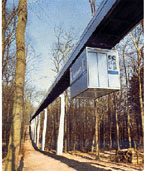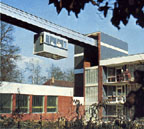Cabinlift
Cabinlift video is available on-line
Note: Cabinlift service has been terminated (November, 2010) as the functions of the two hospitals has changed and it is no longer needed.
 The Cabinlift is made up
of field-proven Cabintaxi components. Its functionality can be described as a
"connector" technology - linking groups of buildings with each other on a
horizontal plane. The experience gained during the testing of the Cabintaxi urban transport
system has been used in the creation of an economically attractive alternative to previous transport
and handling techniques. The Cabinlift's linear motor drive units and rubber-tired wheels
guarantee smooth and quiet travel. A clean form of energy: no problems with exhaust fumes,
odors or noise. It has constant travel characteristics in all types of weather, operates
without a driver (by automatic or semi-automatic control), is guided by a track, can
negotiate gradients and is pollution-free. Being designed to carry passengers, it
incorporates extensive safety features. Its high operational reliability is retained by
means of regular maintenance, and by check-out procedures for certain components.
The Cabinlift is made up
of field-proven Cabintaxi components. Its functionality can be described as a
"connector" technology - linking groups of buildings with each other on a
horizontal plane. The experience gained during the testing of the Cabintaxi urban transport
system has been used in the creation of an economically attractive alternative to previous transport
and handling techniques. The Cabinlift's linear motor drive units and rubber-tired wheels
guarantee smooth and quiet travel. A clean form of energy: no problems with exhaust fumes,
odors or noise. It has constant travel characteristics in all types of weather, operates
without a driver (by automatic or semi-automatic control), is guided by a track, can
negotiate gradients and is pollution-free. Being designed to carry passengers, it
incorporates extensive safety features. Its high operational reliability is retained by
means of regular maintenance, and by check-out procedures for certain components.
Operation and Technical Aspects
Cabinlift is similar to an elevator in its method of functioning. The vehicle is called by pressing a button. An optical indicator shows the direction of travel. The starting button releases the travel blocking mechanism and set the cab in motion. The installation can be guarded against unauthorized operation through key control.
After starting, the cab automatically accelerates to the programmed speed. Before it reaches its destination, the vehicle automatically decelerates to approach speed until it come to a halt at the station.
A built-in speed measuring system, external monitoring of braking paths, two independent braking systems, automatic wheel braking in the event of power failure, battery-powered operation with a special drive vehicle on a separate track: these are all parts of the broad range of safety features.
The ventilated and heated cab, of aluminum light-weight design, has spring-loaded,
cushioned suspension. Each bogie is equipped with rubber-tired trailing and guiding
wheels. The track grider, in the form of a box section bridge, is resistant to torsional
and bending stress. The busbars and the secondary conductor for the drive units and brakes
are installed along the track grider. In addition, other supply lines unrelated to the
Cabinlift installation (main power, emergency power, heating, communications) can be
accommodated along the girder. The track girders are
mounted on supports of
reinforced concrete, as a rule. The stations in or adjacent
to building, as well as the vehicles (3 possible
sizes) themselves, would be designed to comply with local regulations. Illustrations of operating components and
routing (network
design) possibilities are also provided. Several pictures of Cabinlift in operation are also available.
Graphics from a proposal to serve the Bremen
Central Hospital complex in Bremen, Germany with a Cabinlift system show its
excellent application potential.
 These pictures provided
were taken at an installation at the Schwalmstadt-Ziegenhain hospital in Germany. The
attributes of this installation are: 578 meters of guideway, 2 stations, 2 minute travel
time between stations, 12-person carrying capacity, 6 meters/second travel speed, fully
automatic operation, driven by 2 electric asynchronous linear motors that are unaffected
by weather conditions, automatic positioning of vehicle and additional braking system at
both stations. It was built in 1975 over a 12 month period and has been operating
successful since then. Messerschmitt-Bölkow-Blohm GmbH was the vendor and contractor.
These pictures provided
were taken at an installation at the Schwalmstadt-Ziegenhain hospital in Germany. The
attributes of this installation are: 578 meters of guideway, 2 stations, 2 minute travel
time between stations, 12-person carrying capacity, 6 meters/second travel speed, fully
automatic operation, driven by 2 electric asynchronous linear motors that are unaffected
by weather conditions, automatic positioning of vehicle and additional braking system at
both stations. It was built in 1975 over a 12 month period and has been operating
successful since then. Messerschmitt-Bölkow-Blohm GmbH was the vendor and contractor.
More information on this technology (as well as Cabintaxi) can be obtained from Marsden Burger at the Cabintaxi Corporation, in Detroit, MI.
Last modified: November 23, 2010